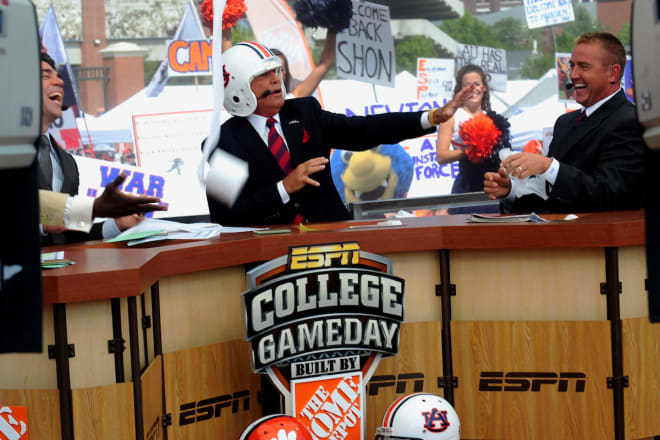BMatt’s Monday musings
AUBURN | It premiered last fall but I finally got around to watching the SEC Storied feature More Than a Voice this weekend.
It was very well done focusing on the iconic play-by-play announcers around the SEC including Auburn’s own Jim Fyffe, Rod Bramblett and Andy Burcham.
It was great hearing many of those iconic calls and seeing those incredible moments that have helped made the Southeastern Conference such a tradition-rich institution.

The SEC Network and ESPN deserve praise for capturing part of the greatness of the SEC, which makes me wonder why they’re working so hard to destroy it.
Perhaps destroy is too harsh of a word, but ESPN with the SEC and Fox with the Big Ten seem bound and determined to turn the Power Five into a Power Two by going as big as 20 teams per league.
Why?
I know the answer, of course. It’s the answer to most every stupid move in college athletics and that’s money — a whole lot of money those networks will pay the SEC and Big Ten to broadcast their games if they include matchups between 40 of the best teams in the country every Saturday.
But is this really good for college football?
I mean does anybody in the Big Ten really want to play UCLA in a conference game every year? The SEC has already expanded west. Is it about to move up the east coast or add more schools from its current footprint?
I get it in some ways. In the current market, it’s either expand or die. The Pac-12 is scrambling right now with USC and UCLA leaving. If they lose a few more schools to the Big Ten of Big 12ish, they could go defunct.
But it’s ESPN and Fox that created this market. And if it reaches its conclusion with two 20-team super conferences, what does the rest of college football look like outside the SEC and Big Ten?
Not too good.
In that scenario, the Big Ten probably poaches Notre Dame and three more from either the Pac-12 or ACC or both. The SEC seems likely to raid the ACC, another league whose media right are held by ESPN.
Some of the candidates that could end up in one of the Power Two along with the Irish include North Carolina, Florida State, Clemson, Miami, Virginia, Virginia Tech, Oregon, Washington or Stanford.
All those traditional rivalries gone with the wind.
When Oklahoma and Texas join the SEC to make it a 16-team league, it’ll seem cool at first. Auburn will play both schools twice every four years.
It may have to give up the Deep South’s Oldest rivalry against Georgia on an annual basis, but hey, that’s progress. I’m sure the SEC/ESPN will keep the Iron Bowl every year because traditions are so important.
But what’s going to happen when the novelty wears off? It was exciting when Auburn played Texas back in 1980’s or Oklahoma in the 2017 Sugar Bowl. It’s great that Auburn is hosting Penn State this year after playing at College Station a year ago. But I doubt it would be as novel if they played twice every four years.
It’s the rivalries that have made the SEC so special over the past 90 years. When the SEC expanded from 10 to 12 teams in 1992, the Auburn-Tennessee rivalry, played continuously from 1958-1991, came to an end. When the league expanded from 12 to 14 in 2002, the Auburn-Florida rivalry, played continuously from 1945-2002, came to an end.
The annual Auburn-LSU rivalry has helped replace those two, but that will certainly be gone by 2026 too.
So in two more years, Auburn will be left with one traditional rival or maybe two if Georgia remains. How many annual rivals can survive an 18- or 20-team league?
Auburn’s odds of winning a championship certainly won’t be better. A team that hasn’t won the conference title since 2013 will have two more powerhouse programs it will have to surpass to compete for a title starting in 2026.
It may seem cool being the biggest and baddest conference in the country, but it’s not so cool when it comes at the expense of all the traditions that made it so special.
***
In today’s musical journey, we go back 52 years to the start of a legendary radio show. On July 4, 1970, the American Top 40 made its debut with host Casey Kasem on just seven radio stations. The inaugural show took 18 hours to produce. In the first year, the show was recorded on reel-to-reel tapes before moving to vinyl in year two. It would be recorded on four records, which would be mailed to radio stations. Within a year, the syndicated show was airing on 115 stations and by the early 1980’s the it had grown to over 500 radio stations and around the world on the Armed Forces Radio Network. It eventually peaked at over 1,000 stations. For the first 21 years, the show used the weekly Top 40 rankings from the Billboard Hot 100 chart. The first No. 1 was Mama Told Me (Not to Come) by Three Dog Night and the top 10 included a Beatles song, No. 8 The Long and Winding Road, and an Elvis song, No. 9 The Wonder of You, for the first and only time in the countdown. Other notable songs in the opening Top 40 include Crosby, Stills, Nash and Young’s Ohio at No. 30, Ray Stevens’ Everything is Beautiful at No. 29, Stevie Wonder’s Signed, Sealed, Delivered at No. 26 and Mountain’s Mississippi Queen at No.21. The show was much more than just a countdown as Kasem incorporated stories about artists and songwriters, trivia and long distance dedications. Kasem signed off the first show as he would every show with, “Keep your feet on the ground and keep reaching for the stars.”
Born Kamal Amin Kasem in 1932 to Lebanese immigrants, Kasem started his radio career covering sports at Northwestern High School in Detroit. He voiced children’s programs such as The Lone Ranger while a student at Wayne State and was drafted into the Korean War in 1952 where he served as a DJ on Armed Forces Radio. He moved to Los Angles in 1963 where he appeared in several T.V. shows including Hawaii Five-O and the Dating Game, and in 1969 became the voice of Shaggy on Scooby-Doo. He launched American Top 40 along with three others the following year and hosted the show until 1988 when Shadow Stevens took over after Kasem was forced out due to a contract dispute. Kasem launched a competing show, Casey’s Top 40, in 1989 on Westwood One. Declining ratings cause America’s Top 40 to be cancelled in 1995, but was relaunched with Kasem back at the helm in 1998. Kasem continued to host until retiring in 2004 and turning over the hosting duties to Ryan Seacrest, who continues in that role today. Kasem passed away in 2014 of Parkinson’s. He received a star on the Hollywood Walk of Fame in 1982 and has been inducted into both the National Association of Broadcasters and National Radio Hall of Fames. Replays of the original American Top 40 can currently be heard on Sirius XM channel 70’s on 7 during weekends.
